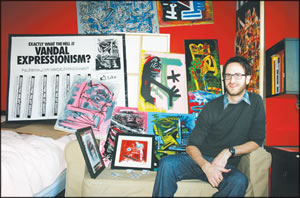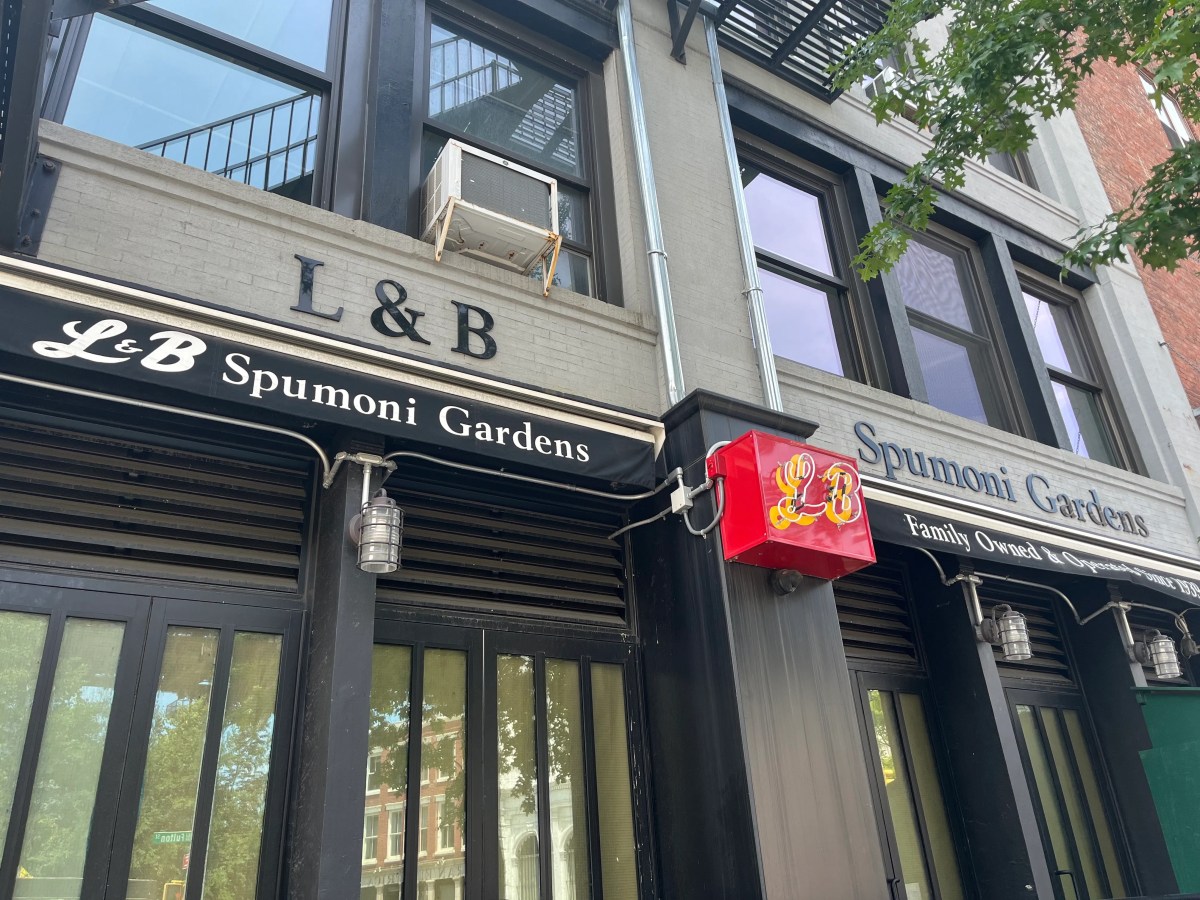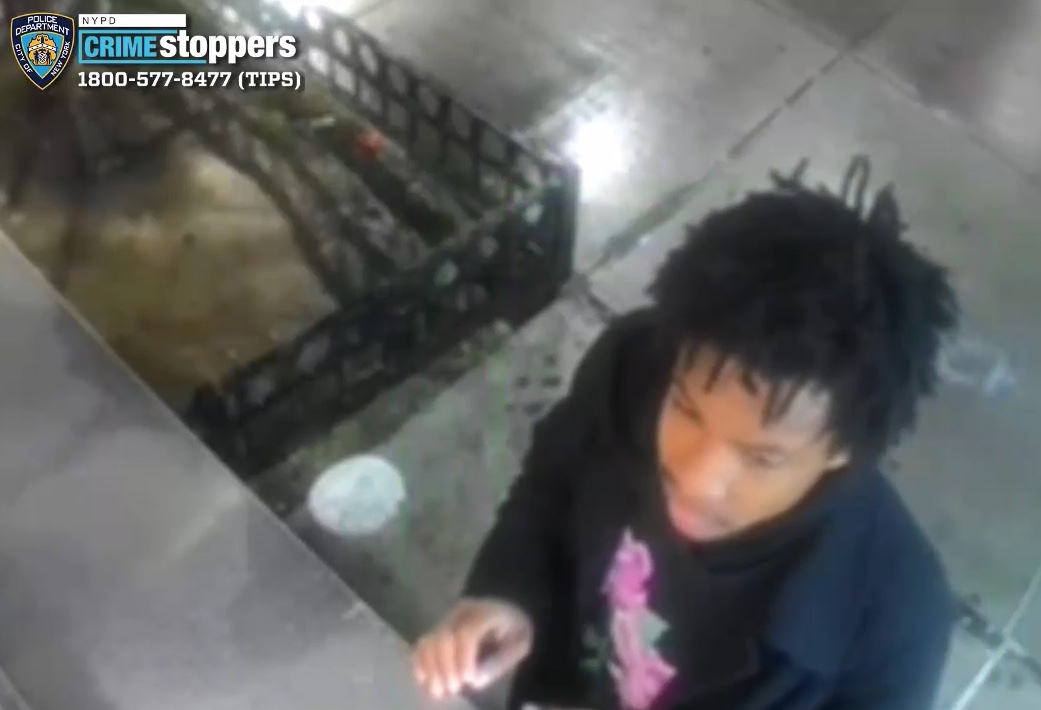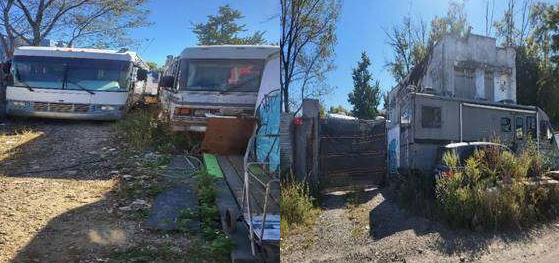BY ALINE REYNOLDS
Meloy’s debut solo exhibit is manifesto-friendly
Vandal Expressionism lets the seams show.
Vandal Expressionism challenges notions of value and damage .
Vandal Expressionism is a blood relative of photography.
In a manifesto he is constantly updating, third generation Lower East Sider Joseph Meloy, 28, challenges the traditionalist artistic norms of values, forms and even damage. Meloy likes to refer to his style as “Vandal Expressionism.”
“It’s almost like a re-appropriation of techniques and aesthetics used to deface and to destroy,” he explained. “If you scribble your name or face on a car, why not take that script and use it to create?”
A recent interview with the effusive, six-foot-five multi-media artist took place amidst the clutter of his Brooklyn studio (which also happens to be a studio apartment). The space, complete with two American Short Hair cats and girlfriend/cook Stephanie, is a cluttered jumble of sketchbooks strewn across the hardwood floor and myriad canvases bunched up against the walls.
On their bed lies yet more sketch books and art stuff that Monkeyman (one of their cats) was destructively chomping on. The studio was more disorderly than usual, Meloy said, since he is preparing for his first solo exhibit at the Le Salon d’Art gallery on Stanton Street. Meloy will showcase several of his graffiti-style pop artworks, filled with colorful swirls that in some instances resemble human, animal and robotic forms; and in others form amorphous patterns that stretch across the canvas.
Inspired by the New York School of Abstract Expressionism of the 1940s and ‘50s, the artist says he is also influenced by “écriture automatique” — a fundamental principal used by Surrealist artists to liberate themselves from reason by way of spontaneous, uncalculated creation. Meloy’s Lower East Side art hero is pop artist Luz Azul (known as “Marco”) — who sells colorful, cartoon-like murals and pop portraits from a truck he drives around Manhattan. “I like his ubiquity,” said Meloy. “You walk down Houston Street, and all the storefronts have his art there.”
Meloy himself is a third-generation Lower East Sider (his parents met there in the late 1960s). “My dad was a cop for the seventh precinct, and my mom grew up there” said Meloy, who fondly recalls as a toddler his first interaction with art — a viewing of “The Lion’s Den” by graffiti artist Lee Quinones. “I called it ‘EINA,’ because I couldn’t pronounce ‘lion,” Meloy said, grinning. He gets the same thrill looking at a photograph of the mural 25 years later. “I’m still affected by it in the way I was as a kid – that this is one seriously scary-ass lion,” said Meloy.
A late bloomer, Meloy graduated from Brooklyn College in 2004 with a degree in linguistics — but without knowing what profession he wanted to pursue. He went through a creative dry spell as an undergraduate. With a Canon Powershot G5 his parents gave him as a graduation gift (his first digital camera), Meloy snapped tens of thousands of photographs of everyday street scenes — motivated in part by experimental photographer Man Ray. “Even if it’s a mundane scene, in sixty years, it’s going to provide a window to this time,” he said.
Meloy delved into visual art in his spare time only nine months ago, when he began to furiously sketch in notepads during his commute to work. “It began to bother me more and more that there was nothing I could touch,” he said of his photographs. Switching mediums, from computer to canvas, Meloy explained, “was a backlash against not having art that would age along with me.”
His paintings typically begin as acrylic-based, with a blank-white canvas that he grinds against the street pavement to “get texture.” Later on, he’ll stain and scratch prints and finished canvases with rocks and shards of glass to give them “character.” Other times, a piece of furniture, cardboard or other “found objects” from the street will be used as a template. Some works will take him half an hour, and others will take several sessions over a couple-month period.
Meloy often superimposes his digital prints onto canvases; and, conversely, he scans his notepad sketches, converting them into high-resolution images and enhancing them in Photoshop.
“The lines between the various creative endeavors, and the media in which I execute them, are all very much blurred,” he said. “They fade into one for me.” He will produce several versions of the same sketch — each conceived utilizing different media; and, while having synergy with one another, each piece deviates enough from the original that it becomes its own original.
The artist divides his time between his family’s two-bedroom apartment on Water Street Downtown and his and Stephanie’s Brooklyn studio.
From time to time, Meloy pops his head into The Skinny, The Botanica, or bars along Avenues A and B, where he’ll freely sketch futuristic patterns into a notepad using paint and ink markers. He’ll start off with a Dewar’s or a Jameson on the rocks, and pace himself with whiskeys.
“It’s still grittier and cheaper [than the West side of Manhattan],” he said of the Lower East Side bar scene, “and it just feels more like home.”
He also frequents ABC No Rio, a community arts center on Rivington Street, to create silkscreen prints – a printing method that uses woven, silk mesh and ink-blocking emulsion to create hand-pulled printed designs.
Meloy does most of his drawing, though, to and from Hicksville, Long Island, where he works as an art director at an engineering firm (whose name he asked not to publish). He creates magazine advertisements there, does graphics for the company’s trade shows and makes the designs for its logos.
Meloy’s ambition is to become a full-time Vandal Expressionist. He is in search of a benefactor that would provide him the resources and studio space to pursue his dream of becoming a venerated visual artist who is known by the masses.
Like Marco, Meloy hopes to cultivate his identity in a New York neighborhood — preferably on the Lower East Side. He is a product of the metropolis, he says, and his works exemplify the raw, urban scene he grew up in. “I’m very serious about this,” he said. “I want to find somebody who could put me up in a space and be my patron, old-world style.” Maybe even the King of Spain, he said, smiling.
But that, he acknowledged, might very well be a pipe dream.
Joseph Meloy will host his solo exhibit, entitled, “Exactly what the hell is Vandal Expressionism?” on Thursday, March 3, from 7-10pm at Le Salon d’Art, 90 Stanton St. on the Lower East Side. The show will be on view through March 31.






































